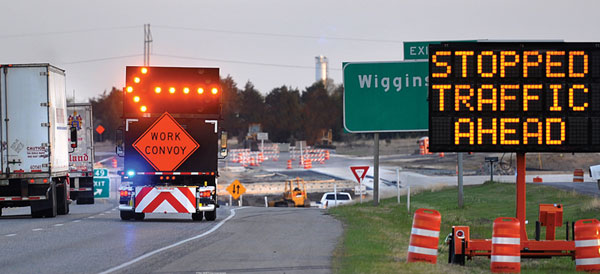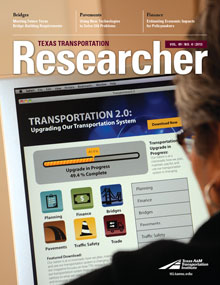TTI Leads Deployment of Innovative Warning System
Although a number of advanced transportation technologies aimed at improving traffic safety are on the horizon, some are already here. Recently TTI helped the Texas Department of Transportation (TxDOT) deploy a unique end-of-queue warning system in work zones. TxDOT is expanding a 96-mile stretch of I-35 in Central Texas to relieve congestion and improve safety. The multi-year effort often requires active work zones during heavy travel times. Closed lanes during construction can slow down traffic or bring it to a stop altogether, sometimes resulting in rear-end collisions, especially at night.

According to the National Highway Transportation Safety Administration, 28 percent of all crashes are rear-end collisions. Risk Management News ranks them as the second most frequent kind of accident, accounting for 38 percent of dollars paid in automobile insurance claims. It’s a no-brainer, really: reducing rear-end collisions can save lives, decrease injuries, and lower societal costs in the form of hospital bills and insurance premiums.
Decreasing the frequency of rear-end collisions during construction along I-35 is the goal of the end-of-queue warning system implemented by TTI. So, how does it work?
Radar detection devices are mounted ahead of work-zone lane closures to monitor and measure the speeds of approaching vehicles. Data from multiple sensors are analyzed, and as vehicles slow down, an algorithm triggers a message for display on portable changeable message signs (PCMSs) located a few miles upstream of the construction site.

“These systems are portable and easy to set up on a nightly basis,” TTI Research Scientist Bob Brydia says. Brydia is principal investigator on the project that implemented the system. “Research indicates that they provide effective communication to drivers.”
When traffic slows or stops, the messages on the PCMSs might read “Slow Traffic — 3 miles” or “Stopped Traffic Ahead.” Keeping motorists better informed decreases the likelihood of rear-end collisions. In turn, workers in the work zone are safer, and the corridor’s overall mobility improves.
TxDOT‘s Waco District will use this new infrastructure to help manage mobility, reduce congestion, and improve safety in the district along I-35 during construction (scheduled for completion in 2017).
“This system lets motorists know how far in advance there is a slowdown,” TxDOT Director of Transportation Operations Larry Colclasure says. “It’s part of the overall effort to provide real-time information designed for motorists’ safety and the safety of the construction workers, too.”
